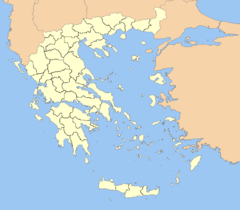Królestwo Grecji (1944–1973)
| Ten artykuł od 2012-03 wymaga zweryfikowania podanych informacji. |
| 1944–1973 | |||||
| |||||
| Język urzędowy | |||||
|---|---|---|---|---|---|
| Stolica | |||||
| Ustrój polityczny | |||||
| Typ państwa | |||||
| Głowa państwa | ostatni Konstantyn II | ||||
| Szef rządu | ostatni Adamandios Andrutsopulos | ||||
| Waluta | |||||
| Ewakuacja wojsk niemieckich | październik-listopad 1944 | ||||
| • Referendum 1973 • Referendum 1974 | • 29 lipca 1973 | ||||
| Religia dominująca | |||||
 | |||||
Królestwo Grecji (gr. Βασίλειον τῆς Ἑλλάδος) – historyczne państwo w dziejach Grecji, istniało w latach 1944-1973.
Na skutek niemieckiej inwazji na Grecję dotychczasowa wojna grecko-włoska zaczęła przybierać dla Greków zły obrót. Po bitwie o Kretę, 1 czerwca 1941 roku, upadł ostatni punkt oporu Greków, rząd wyjechał do Egiptu. W kraju powstał rząd kolaboracyjny, rząd desygnowany przez króla powrócił do kraju po wyzwoleniu, a król Jerzy II w 1946 roku i przy trwającej wojnie domowej rządził do swej śmierci. W latach 1947-1964 rządził jego brat, Paweł I. Syn Pawła, Konstantyn II został w 1967 roku obalony przez wojskowy zamach stanu. W referendum w 1973 roku monarchia została zniesiona, a po upadku junty przeprowadzono kolejne referendum w 1974 roku, które ostatecznie obaliło monarchię.
Media użyte na tej stronie
Outline map of the prefectures of Greece with a dark outline
Coat of arms of the Kingdom of Greece in 1936–1973
- Royal Coat of Arms of Greece under the Glücksburg dynasty, created after the restoration of King George II to the throne in 1935, to the exile of King Constantine II in 1967 and finally until the abolition of the monarchy in 1973.
- The Escutcheon features the white cross on a dark blue field of Greece. The Inescutcheon features the Arms of the Greek line of the House of Schleswig-Holstein-Sonderburg-Glücksburg. The shield is then topped with a golden Royal Crown.
- It features an escutcheon divided by the red and white cross of the Order of the Danneborg, the first quarter features the arms of Denmark (three crowned blue lions and nine hearts in yellow field). The second of Schleswig (two blue lions passant in yellow field). The third divided into four; the chief features the three royal crowns in blue field of Sweden, the second half with a crowned stockfish on red field of Iceland and the last half divided between the ram of the Faroe Islands and a polar bear of Greenland, both on blue fields. The fourth quarter is divided between two halves, the chief depicts a yellow field with a blue lion passant over nine red hearts of the King of the Goths, the lower half depicts a crowned golden lindorm on a red field of the King of the Wends.
- Upon it is another inescutcheon in red, divided into four quarters: the first a a silver nettle leaf of Holstein, the second the a swan with a golden crown of Stormarn, the third a knight dressed in golden armor on a silver horse of Dithmarschen and the fourth of a golden horse's head of Lauenburg.
- Upon it is another inescutcheon divided the first features the red and yellow bars of Oldenburg, the second a golden cross on a blue field of Delmenhorst.
- The escutcheon rests on a golden pedestal and supported by two human figures representing the Greek mythological hero Herakles (Hercules), holding a wooden club and wearing the skin of the Nemean lion.
- The escutcheon is surrounded by the ribbon and cross of the Order of the Redeemer, the cross depicts Christ Pantocrator, surrounded by the order's motto:"Η ΔΕΞΙΑ ΣΟΥ ΧΕΙΡ, ΚΥΡΙΕ, ΔΕΔΟΞΑΣΤΑΙ ΕΝ ΙΣΧΥΙ" or "Thy right hand, O Lord, is become glorious in power" from Exodus, 15:6.
- The motto of the Coat of arms and of the dynasty, depicted on a golden ribbon below the pedestal reads: "Ἰσχύς μου ἡ ἀγάπη τοῦ λαοῦ" or "The people's love, my strength"
- The coat of arms is then surrounded by a dark blue mantle and topped with another royal crown.



